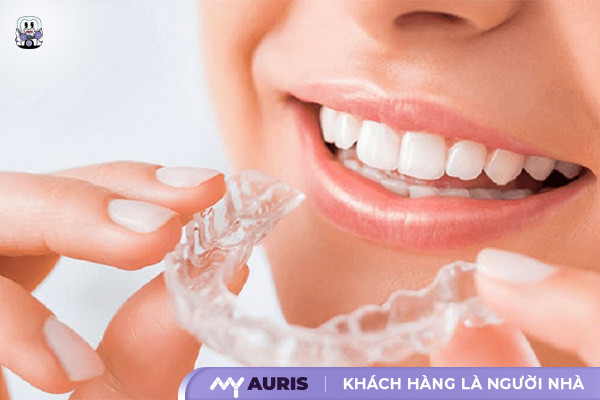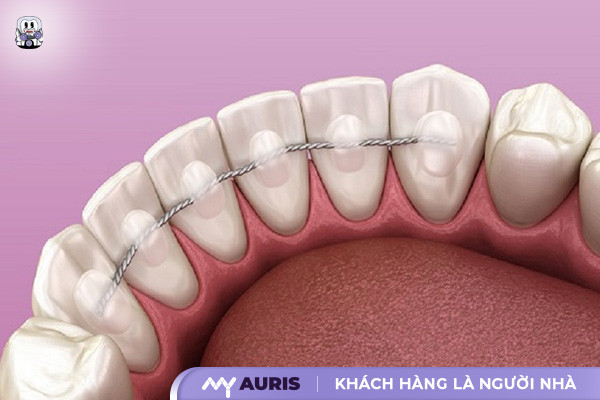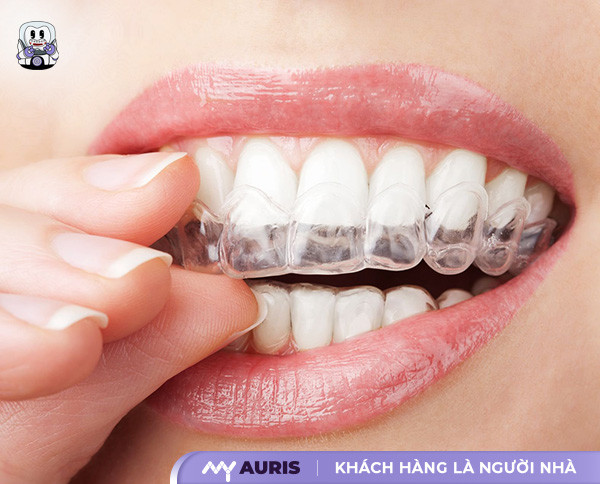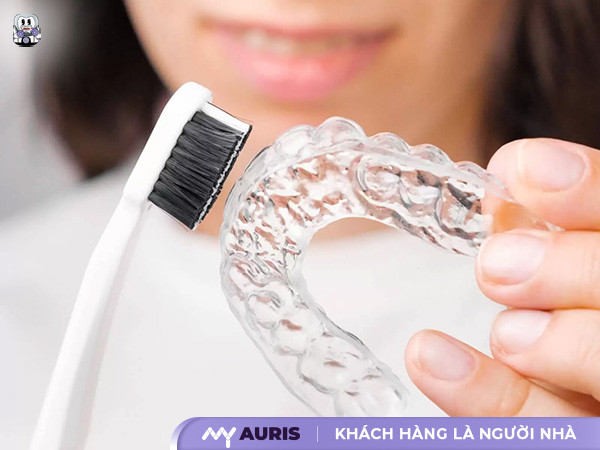Retainers are important appliances that patients need to wear after removing braces to keep teeth stable in their new positions. Failure to wear retainers correctly can cause teeth to shift back, losing the entire treatment result. This is a mandatory step in completing orthodontic treatment.
What are Retainers?
A retainer is a special orthodontic appliance that helps stabilize teeth in their new position after braces are removed, as prescribed by the orthodontist. There are many different types of retainers, including fixed retainers, removable retainers, and wire retainers. Depending on each individual’s orthodontic treatment process and the orthodontist’s recommendation, the chosen appliance will suit their specific oral condition.
An important point to understand is that retainers are not optional, but a mandatory part of the treatment plan. If retainers are not worn, teeth can relapse, leading to the loss of previously achieved orthodontic results. In some cases, users may even have to restart orthodontic treatment from scratch, incurring costs and causing psychological distress.
What are the common types of retainers available today?
To choose the right type of retainer that suits your dental condition and personal needs, you need to understand each type currently available on the market. Below are the common post-braces retention appliances widely used by orthodontists:

Removable Retainers
These are made from clear plastic or hard plastic combined with metal wires. Users can remove them for cleaning or when necessary. The biggest advantages of this type are convenience, ease of cleaning, and no hindrance during eating.
Removable retainers are divided into two main groups:
- Clear plastic retainers (Essix retainers): are custom-molded to fit snugly over each tooth, offering high aesthetics and being very difficult to see when worn. However, their durability is not as high as fixed retainers.
- Wire retainers (Hawley retainers): have a metal wire that hugs the front surface of the teeth, combined with a plastic base. Although more visible than clear retainers, they are more durable and have a lower cost.
The daily wearing time typically ranges from 8 to 20 hours, depending on the case and as prescribed by the orthodontist.

Fixed Retainers
This type is bonded directly to the back surface of the teeth, typically from canine to canine, using a thin metal wire. Since it cannot be removed by the user, its effectiveness in retaining teeth is very stable and almost independent of the user’s habits.
Advantages:
- Cannot be forgotten or lost as they are not removable
- Does not affect aesthetics as they are hidden behind the teeth
- Does not cause pain if bonded correctly
However, fixed retainers have the disadvantage of being difficult to clean, easily accumulating plaque if not given proper attention. Wearers need to clean them thoroughly with specialized dental floss or a water flosser to prevent gingivitis.
Clear Retainers (Essix Retainers)
This type of retainer is designed similarly to Invisalign aligners, made from clear plastic material. The retainer is custom-molded to the shape of the teeth after orthodontic treatment, fitting snugly over the entire arch.
The strengths of this type are:
- High aesthetic appeal, almost invisible when worn
- Easy to remove and clean
- Does not cause pain if worn as prescribed
The weaknesses are:
- Lower durability than metal types
- Can deform if exposed to high temperatures
Typically, Essix retainers are recommended to be worn at night to maintain the stability of teeth after braces.
Combination Retainers
Some cases require a combination of the above two types, meaning wearing fixed retainers during the day and removable ones at night to enhance retention effectiveness. The treatment plan will be personalized based on the treating dentist’s assessment.
Summary Table Comparing Retainer Types
| Criterion | Fixed | Removable (Clear Plastic) | Removable (Wire) |
| Retention Capability | Very Good | Good if worn correctly | Good |
| Durability | High | Medium | High |
| Aesthetics when worn | High | Very High | Medium |
| Removability | No | Yes | Yes |
| Ease of Cleaning | Difficult | Easy | Easy |
| Cost (approx.) | 1 – 3 million VND | 2 – 4 million VND | 1.5 – 3 million VND |
| Suitable for | Forgetful individuals | Individuals requiring high aesthetics | Individuals needing flexibility |
How long should retainers be worn?
According to orthodontists at My Auris Dental Clinic, the ideal retainer wearing period typically ranges from 6 months to 2 years, depending on the type of appliance, age, and jawbone stability. There are two phases:
- Initial phase (first 6 – 12 months): This is when continuous daily wear is mandatory (minimum 20 – 22 hours/day), even during sleep. The goal is to help stabilize the new tooth positions in the dental arch.
- Long-term retention phase (after 1 year): The wearing frequency can gradually be reduced to nighttime only. Some cases may require retention for several years if the jawbone is weak or teeth were severely misaligned.
The type of retainer also influences the wearing duration:
Fixed retainers: Bonded to the inner surface of the teeth, usually worn continuously for 1 – 5 years, non-removable. The advantage is no need for reminders, reducing errors due to forgetting to wear.
Removable retainers: Usually clear plastic or metal with clasps. Easy to remove and clean, but require strict adherence to wearing time by the user.

How much do retainers cost?
Retainers cost from 1,000,000 to 4,000,000 VND, and the price depends on several factors such as:
- Type of retainer: removable or fixed
- Material: metal, hard plastic, clear plastic
- Location of treatment: large dental clinics, specialist orthodontists
- Complexity of the dental arch after orthodontics
Additionally, some aesthetic retainer types like clear trays or composite retainers will be more expensive than conventional types.
Reference Price List for Common Retainers
| Retainer Type | Material | Price Range (VND) | Key Features |
| Fixed Retainer | Metal wire, composite | 1,000,000 – 2,000,000 | Non-removable, durable, discreet |
| Traditional Removable Retainer | Hard plastic, archwire | 1,200,000 – 2,500,000 | Removable, easy to clean |
| Clear Retainer | High-grade clear plastic | 2,000,000 – 4,000,000 | Highly aesthetic, hard to notice when worn |
Choosing the right type of retainer should not solely depend on the price. The most important factors are long-term retention effectiveness, suitability for your dental arch, and lifestyle. If you prioritize aesthetics, a clear retainer is an ideal choice. If durability and cost-effectiveness are your priorities, a fixed metal wire retainer is a reasonable solution.
How to properly care for and clean your retainers
Proper retainer care is a crucial factor in determining stable results after braces. If not properly cleaned and maintained, users may encounter issues such as gum inflammation, appliance damage, or teeth shifting back. Below are specific, easy-to-follow instructions suitable for both removable and fixed retainers.
Daily cleaning of removable retainers
Removable retainers are typically made from clear plastic or a combination of plastic and metal. Since they can be removed, daily cleaning should be performed regularly following these steps:
- Gently remove the retainer: Use clean hands to remove the retainer, avoiding strong pulling that could break or warp the appliance.
- Brush with a soft brush: Use a separate soft-bristled toothbrush for your retainer, along with mild soap or a specialized cleaning solution. Avoid using toothpaste as it can scratch the surface.
- Soak the retainer: 1-2 times a week, you should soak the appliance in a specialized cleaning solution (as per your orthodontist’s instructions) to remove deep plaque.
- Rinse with clean water: After brushing or soaking, thoroughly rinse the appliance with plain water to remove chemicals.

Thorough care for fixed retainers
Fixed retainers are bonded directly to the inner surface of the teeth using a metal wire or composite material. Since they cannot be removed, wearers need to pay closer attention to cleaning:
- Use specialized dental floss: Floss with a stiff end or a floss threader helps guide it between teeth, cleaning the area under the retention wire.
- Use interdental brushes: Small brush heads can be threaded into the spaces between the wire and teeth, effectively removing plaque.
- Brush teeth correctly: Brush teeth at least twice a day with a soft-bristled toothbrush, gently brushing the area in contact with the fixed wire to prevent long-term plaque buildup.
- Rinse with salt water or antibacterial mouthwash: Helps reduce the risk of gingivitis due to food trapped in the archwire.
Other notes on usage and maintenance
- Do not wear removable retainers while eating: To avoid damaging metal clasps and prevent food particles from getting trapped and causing bacteria buildup.
- Avoid hot water and strong chemicals: Do not soak the appliance in hot water, and avoid using alcohol, vinegar, or highly acidic solutions as they can cause deformation.
- Do not leave retainers exposed to air: If not in use, store them in a specialized vented case to prevent bacterial growth.
- Regular check-ups: At least every 3–6 months to check the durability of the appliance, the condition of your teeth, and make adjustments if necessary.
When to replace or repair your retainer
Retainers, whether removable or fixed, have a certain lifespan. Some signs that you should consult your orthodontist include:
- The appliance is cracked, broken, or warped
- It feels loose or insecure when worn
- Teeth show signs of shifting back
- You experience pain or discomfort when wearing it
Optimize retainer effectiveness with good habits
- Wear for the prescribed duration: A minimum of 8 hours/day, ideally all day (except when eating or cleaning).
- Combine with a low-sugar, high-vegetable diet to prevent plaque buildup.
- Always maintain thorough oral hygiene habits.
Proper care and cleaning of retainers is an unskippable step in the post-orthodontic phase. Consider this a continuation of the braces treatment process, contributing to stable results, preventing teeth from shifting back, and improving long-term oral health.





